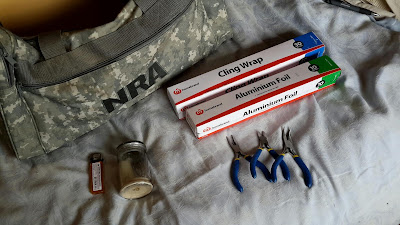Hi everyone,
A few months ago I wrote about the contents of my SES kitbag. This post is a second chapter in "showing us your kits".
In the boot of my car I have my first aid bag. I decided to build my own first aid bag rather than buy a pre-made one from St John Ambulance or Red Cross. It enables me to customise it to injuries I think I'm likely to encounter. More importantly, it was cheaper. So, what do I have?

The first item is the bag itself. Yes, it's in camouflage colours, and yes, it does say "NRA". It came free with renewing my membership of the National Rifle Association.

The first bundle of items in the bag are cotton balls and cotton tips for wound care. Along wth them is a triangular bandage for use as a sling, in binding limbs following snakebite, and as a general bandage. I also have fabric and plastic bandaids, and a box of rubber gloves (they were cheaper than non-latex gloves; economics requires me to hope that I won't have to treat someone with a latex allergy).

I found that take away containers are ideal for packing things that are prone to leak or burst, and they'll also double as dishes for antiseptic and other fluids. In this one I've stored a bottle of antiseptic and a pack of antibacterial wipes.

The next bundle contains a 1 litre bottle of methylated spirits. "Metho" has a range of uses - it's a brutal but effective antiseptic, it can light a fire (if you're careful), and it eases insect bites. In the same bundle I have another triangular bandage, two instant icepacks, and an empty water bottle (I'll be the first to admit that it's there under the "it'll come in handy" principle).

The next bundle is a tape measure, antibacterial soap, paper tape and a torch.

Another take-away container contains medication: Hirudoid cream (for treating bruising), antiseptic cream (use is fairly obvious), hand sanitiser, and boxes of paracetamol, aspirin and ibuprofen. This box also contains a crepe bandage, safety pins, tongue depressers and a penknife.

Towards the bottom of the bag is a candle in a sealable jar and a cigarette lighter (as a last-ditch source of light, and as a source of fire). There are also pliers and snips of various types for dealing with embedded objects. In general, embedded objects should be left in place to avoid causing further injury or bleeding. However, cutting an object back may be necessary for casualty comfort, and removing fishhooks is likely to require pliers. The rolls of clingwrap and aluminium foil are for sealing wounds against contaminants, especially burns or anything where a significant amount of skin has been removed. n addition, clingwrap can be used to treat open chest wounds: a patch of clingwrap is taped on three sides over the wound, creating a kind of one-way valve.

At the side of the bag in a stiff envelope are two large non-adherent dressings, as well as the American Red Cross guide to wilderness and remote first aid. I also carry a copy of the Australian first aid text book, and a 24 pack of AAA batteries.

In one of the end pockets of the bag are some general emergency resources: scissors, insect repellent, caffeine tablets, a bushfire awareness card, a bible, a notebook and a sealable tin.

In the other end pocket are some further general resources: some rather crappy field glasses, a solar- and wind up-powered radio, a cooling bandana, duct tape, a plastic rain poncho and a biro.
On the to-buy list for me are a couple of military-issue trauma bandages, which have fittings which allow them to be fastened firmly in place on an injury, and also a tourniquet (these are coming back into acceptance for preventing catastrophic blood loss). I should also buy (don't laugh) a box of tampons, as these are recommended for managing puncture wounds where the object is not embedded in place.
So there you have it. Do you carry any first aid gear with you? Or any other emergency items? What do you have?
No comments:
Post a Comment